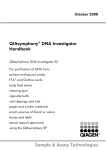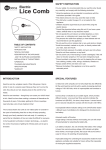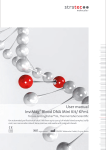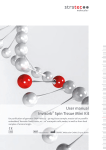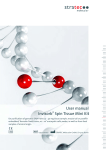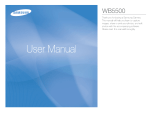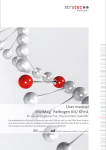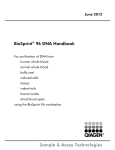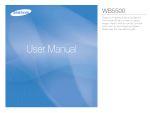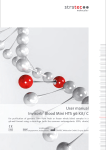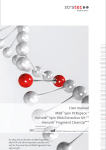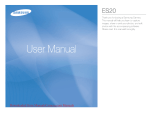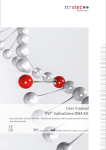Download Invisorb Spin Forensic Kit
Transcript
User manual Invisorb® Spin Forensic Kit For purification of genomic DNA from forensic samples, like small human whole blood samples, blood cards, biopsy samples, body fluids, nails, hair roots, teeth, bones et al. IVD REF 1034110x00 STRATEC Molecular GmbH, D-13125 Berlin Instruction for Invisorb® Spin Forensic Kit The Invisorb® Spin Forensic Kit permits the easy and fast manual isolation and purification of genomic DNA from forensic samples, like small human whole blood samples, blood cards (dry blood stain), biopsy samples, body fluids, nails, hair roots, chewing gum, cigarette butts, stamps and envelops, teethes and bones for in vitro diagnostic analysis. The kit is neither validated for the isolation of genomic DNA from cell free body fluids, non mammalian blood, bacteria, fungi, parasites, viruses, or the purification of total RNA. IVD Not for in vitro diagnostic use in countries where the EU Directive 98/79/EC on in vitro medical devices is not recognized. Trademarks: Invisorb®. Registered marks, trademarks, etc. used in this document, even when not specifically marked as such, are not to be considered unprotected by law. The Invisorb® technology is covered by patents and patent applications: US 6,110363, US 6,043,354, US 6,037,465, EP 0880535, WO 9728171, WO 9534569, EP 0765335, DE 19506887, DE 10041825.2, WO 0034463. Invisorb® is a registered trademark of STRATEC Biomedical AG. The PCR process is covered by US Patents 4,683,195, and 4,683,202 and foreign equivalents owned by Hoffmann-La Roche AG. © 2015 STRATEC Molecular, all rights reserved. 1 ® Invisorb Spin Forensic Kit 0515 Contents Kit contents of the Invisorb® Spin Forensic Kit............................................................. 3 Symbols ................................................................................................................... 4 Storage ................................................................................................................... 4 Quality control and warranty .......................................................................................... 4 Intended use ................................................................................................................... 5 Product use limitation ..................................................................................................... 5 Technical assistance....................................................................................................... 6 Safety information ........................................................................................................... 6 Product characteristic of the Invisorb® Spin Forensic Kit............................................ 7 Sampling and sample storage ........................................................................................ 8 Principle and procedure ................................................................................................. 9 Important notes ............................................................................................................... 9 Important points before starting a protocol .................................................... 9 Preparing reagents and buffers ..................................................................... 10 Reagents and equipment to be supplied by user ....................................................... 11 For purification of DNA from dried blood ...................................................... 11 For purification of DNA from forensic surface and contact swabs ............. 11 For purification of DNA from chewing gum ................................................... 11 For purification of DNA from bones or teeth ................................................. 11 Important indications .................................................................................................... 12 Scheme of the Invisorb® Spin Forensic Kit ................................................................. 13 Protocol 1: DNA isolation from blood stains ....................................................... 14 Protocol 2: DNA isolation from buccal swabs .................................................... 15 Protocol 3: DNA isolation from saliva stains ...................................................... 15 Protocol 4: DNA isolation from hair roots ........................................................... 15 Protocol 5: DNA isolation from cigarette butts ................................................... 16 Protocol 6: DNA isolation from chewing gum ..................................................... 16 Protocol 7: DNA isolation from stamps and envelopes ...................................... 16 Protocol 8: DNA isolation from tissue samples .................................................. 17 Protocol 9: DNA isolation from nail clippings ..................................................... 17 Protocol 10: DNA isolation from bones or teeth ................................................. 18 Protocol 11: Isolation of DNA from sperms (sperms mixed with epithelial cells), semen stains and swabs with sperms ................. 18 Protocol 12: DNA isolation from 50 µl whole blood 20 Protocol 13: DNA isolation from blood cards 21 Protocol 14: DNA isolation from eukaryotic cell pellets (100 - <105 cells ) 22 Protocol 15: DNA isolation from 50 µl eukaryotic cell suspension or body fluids (<105 cells) 23 Protocol 16: DNA isolation from small tissue samples, frozen sections and biopsy samples 24 Protocol 17: DNA isolation from mouth brushes (swabs) 25 Troubleshooting 26 General notes on handling 27 Ordering information 28 2 ® Invisorb Spin Forensic Kit 0515 Kit contents of the Invisorb® Spin Forensic Kit Store the kit components at room temperature (RT)! Store lyophilized Carrier RNA at 2 – 8 °C! Store dissolved Proteinase K and dissolved Carrier RNA at - 20° C! 5 DNA extractions 50 DNA extractions 250 DNA extractions 1034110100 1034110200 1034110300 Bone Lysis Enhancer 6 ml 50 ml (not provided)* 250 ml (not provided)* Lysis Buffer M 2 ml 3 x 2 ml 30 ml 240 µl working solution 1.2 ml working solution 3 x 2 ml working solution RNase Free Water 2 ml 2 ml 3 x 2 ml Binding Buffer B6 2 x 1 ml (ready to use) 4 ml (final volume 15 ml) 2 x 9 ml (final volume 2 x 30 ml) Proteinase K for 250 µl working solution for 550 µl working solution for 5 x 550 µl working solution Wash Buffer I 15 ml (ready to use) 30 ml (final volume 60 ml) 80 ml (final volume 160 ml) Wash Buffer II 15 ml (ready to use) 18 ml (final volume 60 ml) 60 ml (final volume 200 ml) Elution Buffer 2 ml 15 ml 30 ml RTA Spin Filter Set 5 50 5 x 50 RTA Receiver Tubes 5 50 5 x 50 1.5 ml Receiver Tubes 5 50 5 x 50 Manual 1 1 1 Add 11 ml 99.7% Isopropanol to the Binding Buffer B6. Mix by intensive shaking by inverting for 1 min. Shortly before use mix by inverting several times Add 42 ml 99.7% Isopropanol to the Binding Buffer B6. Mix by intensive shaking by inverting for 1 min. Shortly before use mix by inverting several times Add 550 µl ddH2O to Proteinase K, mix thoroughly until completely dissolving and store at 20°C! Add 550 µl ddH2O to Proteinase Kmix thoroughly until completely dissolving and store at 20°C! Add 1.2 ml RNase Free Water to Carrier RNA, mix thoroughly until completely dissolving and store at 20°C! Add 2.0 ml RNase Free Water to each Carrier RNA, mix thoroughly until completely dissolving and store at -20°C! Add 30 ml of 96–100 % ethanol to the bottle Wash Buffer I Add 80 ml of 96-100 % ethanol to the bottle Wash Buffer I Add 42 ml of 96-100 % ethanol to the bottle Wash Buffer II, mix thoroughly and keep the bottle always firmly closed! Add 140 ml of 96–100 % ethanol to the bottle Wash Buffer II, mix thoroughly and keep the bottle always firmly closed! Catalogue No. Carrier RNA Initial steps Add 250 µl ddH2O to Proteinase K, mix thoroughly until completely dissolving and store at 20°C! Add 240 µl RNase Free Water to Carrier RNA, mix thoroughly until completely dissolving and store at 20°C! *) Bone Lysis Enhancer order no: 1034101900 3 ® Invisorb Spin Forensic Kit 0515 Symbols Manufacturer Lot number Catalogue number Expiry date Consult operating instructions Temperature limitation Do not reuse Storage All buffers and kit components, except the dissolved Proteinase K and the Carrier RNA, of the Invisorb® Spin Forensic Kit should be stored well sealed and dry at room temperature (RT) and are stable for at least 12 months under these conditions. Proteinase K: Dissolved Proteinase K must be stored at –20 °C. Dividing the Proteinase K into aliquots and storage at –20 °C is recommended. Carrier RNA: Lyophilized Carrier RNA can be stored at 2 - 8°C or at RT, but the recommendation for long time storage is –20°C. Dissolved Carrier RNA must be stored at -80°C, but repeated freezing and thawing will degrade the Carrier RNA and reduce the functionality of the kit. Therefore dividing Carrier RNA into aliquots and storage at –80°C is recommended. Wash Buffer I and II: Wash Buffers charged with ethanol should be stored at room temperature and should be appropriate sealed. If there are any precipitates within the provided solutions solve these precipitates by careful warming up to room temperature (up to 30 °C). 1 M DTT (not provided): Store the 1 M DTT solution at - 20°C to prevent oxidative damage. Under this condition the solution of 1 M DTT is stable for 12 months. Before every use make sure that all components have room temperature. If there are any precipitates within the provided solutions solve these precipitates by warming carefully. Room temperature is defined as range from 15 – 30°C. Quality control and product warranty STRATEC Molecular warrants the correct function of the Invisorb® Spin Forensic Kit for applications as described in this manual. Purchaser must determine the suitability of the Product for its particular use. Should any Product fail to perform the applications as described in the manual, STRATEC Molecular will check the lot and if STRATEC Molecular investigates a problem in the lot, STRATEC Molecular will replace the Product free of charge. STRATEC Molecular reserves the right to change, alter, or modify any Product to enhance its performance and design at any time. In accordance with STRATEC Molecular’s ISO 9001-2000 and ISO EN 13485 certified Quality Management System the performance of all components of Invisorb® Spin Forensic Kit have been tested separately against predetermined specifications routinely on lot-to-lot to ensure consistent product quality. If you have any questions or problems regarding any aspects of Invisorb® Spin Forensic Kit or other STRATEC Molecular products, please do not hesitate to contact us. A copy of STRATEC 4 ® Invisorb Spin Forensic Kit 0515 Molecular’s terms and conditions can be obtained upon request or are presented at the STRATEC Molecular webpage. For technical support or further information please contact: from Germany +49-(0)30-9489-2901/ 2910 from abroad +49-(0)30-9489-2907 or contact your local distributor. Intended use The Invisorb® Spin Forensic Kit is suitable for reproducible purification of genomic DNA from samples encountered in forensic, human-identity, and biosecurity analyses. The purification is very efficient and the isolated DNA performs well in downstream applications, such as quantitative PCR and STR analysis, with high signal-to-noise ratios. Using the Invisorb® technology, the Invisorb® Spin Forensic Kit permits easy isolation and purification of genomic DNA from small human whole blood samples, blood cards (dry blood stain), biopsy samples, body fluids and other forensic samples for in vitro diagnostic analysis only. Due to the high purity, the isolated genomic DNA is ready to use for a broad panel of downstream applications. The DNA can be stored at –20°C for subsequent use. THE PRODUCT IS INTENDED FOR USE BY PROFESSIONALS ONLY, SUCH AS TECHNICIANS, PHYSICIANS AND BIOLOGISTS TRAINED IN MOLECULAR BIOLOGICAL TECHNIQUES. It is designed to be used with any downstream application employing enzymatic amplification or other enzymatic modifications of DNA followed by signal detection or amplification. Any diagnostic results generated by using the sample preparation procedure in conjunction with any downstream diagnostic assay should be interpreted with regard to other clinical or laboratory findings. To minimize irregularities in diagnostic results, adequate controls for downstream applications should be used. The kit is in compliance with EU Directive 98/79/EC on in vitro medical devices. But it is not for in vitro diagnostic use in countries where the EU Directive 98/79/EC on in vitro medical devices is not recognized. Product use limitation The kit is neither validated for the isolation of genomic DNA from serum, plasma, bacteria, fungi nor from parasites or isolation and purification of total RNA. The included chemicals are only useable once. Differing of starting material or flow trace may lead to inoperability; therefore neither a warranty nor guarantee in this case will be given, neither implied nor express. The user is responsible to validate the performance of the STRATEC Molecular Product for any particular use. STRATEC Molecular does not provide for validation of performance characteristics of the Product with respect to specific applications. STRATEC Molecular Products may be used e.g.in clinical diagnostic laboratory systems conditioned upon the complete diagnostic system of the laboratory the laboratory has been validated pursuant to CLIA’ 88 regulations in the U.S. or equivalents in other countries. All Products sold by STRATEC Molecular are subject to extensive quality control procedures (according to ISO 9001-2000 and ISO EN 13485) and are warranted to perform as described herein. Any problems, incidents or defects shall be reported to STRATEC Molecular immediately upon detection thereof. The chemicals and the plastic parts are for laboratory use only; they must be stored in the laboratory and must not be used for purposes other than intended. The Product with its contents is unfit for consumption. 5 ® Invisorb Spin Forensic Kit 0515 Technical assistance At STRATEC Molecular we pride ourselves on the quality and availability of our technical support. Our Technical Service Department are staffed by experienced scientists with practical and theoretical expertise in the use of STRATEC Molecular products. If you have any questions or experience any difficulties regarding the Invisorb® Spin Forensic Kit or STRATEC Molecular products in general, please do not hesitate to contact us. For technical assistance and more information please call one of the STRATEC Molecular Technical Service Departments or local distributor. Safety information When and while working with chemicals, always wear a suitable lab coat, disposable gloves, and protective goggles! Avoid skin contact! Adhere to the legal requirements for working with biological material! For more information, please consult the appropriate material safety data sheets (MSDS). These are available online in convenient and compact PDF format at www.stratec.com for each STRATEC Molecular Product and its components. If buffer bottles are damaged or leaking, WEAR GLOVES, AND PROTECTIVE GOGGLES when discarding the bottles in order to avoid any injuries. STRATEC Molecular has not tested the liquid waste generated by the Invisorb® Spin Forensic Kit procedures for residual infectious materials. Contamination of the liquid waste with residual infectious materials is highly unlikely, but cannot be excluded completely. Therefore, liquid waste must be considered potentially infectious and be handled and discarded according to local safety regulations. European Community risk and safety phrases for the components of the Invisorb® Spin Forensic Kit to which they apply are listed below as follows: Lysis Buffer M Proteinase K warning H302-315-319 P280-305-351-338 danger H315-319-334-335 P280-305-351-338-310-405 Wash Buffer I warning H302-312-332-412 EUH032 P273 H302: H315: H319: H334: H335: H312: H332: H412: EUH032: P280: P305+P351+P338: P310: P405: P273: Harmful if swallowed. Causes skin irritation. Causes serious eye irritation. May cause allergy or asthma symptoms or breathing difficulties if inhaled. May cause respiratory irritation. Harmful in contact with skin. Harmful if inhaled. Harmful to aquatic life with long lasting effects. Contact with acids liberates very toxic gas. Wear protective gloves/protective clothing/eye protection/face protection. IF IN EYES: Rinse cautiously with water for several minutes. Remove contact lenses, if present and easy to do. Continue rinsing. Immediately call a POISON CENTER or doctor/physician. Store locked up. Avoid release to the environment. Emergency medical information can be obtained 24 hours a day from infotrac: outside of USA: 1 – 352 – 323 – 3500 in USA : 1 – 800 – 535 – 5053 6 ® Invisorb Spin Forensic Kit 0515 Product characteristic of the Invisorb® Spin Forensic Kit Time for preparation Starting material Yield Forensic samples: blood stains, saliva stains, hair roots, cigarette butts, bubble gum, stamps and envelopes, tissue samples, nail clippings, bones, teeth, sperms up to 2 µg depends on type and amount of starting material 15 – 45 min 50 µl whole blood, blood cards, eukaryotic cell pellets (100 5 5 <10 cells ), 50 µl eukaryotic cell suspension or body fluids (<10 cells), small tissue samples, frozen sections and biopsy samples mouth brushes (swabs) The Invisorb® Spin Forensic Kit uses the well-established Invisorb® technology to provide an fast way to isolate genomic and mitochondrial DNA from above named starting material in 15 - 40 minutes. The extracted DNA possess excellent quality, is suitable for a wide range of downstream applications. The kit is designed for simultaneous processing of multiple samples. The raw material is lysed under sample specific conditions in an optimized lysis buffer containing carrier nucleic acid. While the lysis proceeds the proteins are degraded with Proteinase K. The DNA binds after the direct lysis step to the membrane. Contaminants, like potent inhibitors and proteins pass trough, leaving pure DNA to be eluted in either water or the buffer provided with the kit. For reproducible and high yields appropriate sample storage is essential. Yields may be varying from sample to sample depending on factors such as the age of the sample or the storage conditions. The procedure requires neither phenol/ chloroform extraction nor alcohol precipitation. It requires minimal interaction by the user, allowing safe handling of potentially infectious samples. The procedure is designed to avoid sample-to-sample cross-contamination. Due to the high purity, the isolated genomic DNA is ready to use for a broad panel of downstream applications (see below) or can be stored at –20°C for subsequent use. Downstream Application: ○ PCR *) ○ Short Tandem Repeat Analysis (STR) ○ Genetic Typing ○ Laser Micro dissection PCR (LMD) ○ RFLP-Analysis ○ Hybridization The product is intended for use by professional users such as technicians, physicians and biologists trained in molecular biological techniques. It is designed to be used with any downstream application employing enzymatic amplification or other enzymatic modification of DNA followed by signal detection. Any diagnostic results generated using the sample preparation procedure in conjunction with any downstream diagnostic assay should be interpreted with regard to other laboratory findings. To minimize irregularities in results, adequate controls for downstream applications should be used. For further information please contact: Phone: +49 (0) 30 9489 2901, 2910 in Germany and from foreign countries phone: +49 (0) 30 9489 2907 or your local distributor. *) The PCR process is covered by US Patents 4,683,195, and 4,683,202 and foreign equivalents owned by HoffmannLa Roche AG. 7 ® Invisorb Spin Forensic Kit 0515 Sampling and sample storage General sample storage Samples should be store at conditions and temperature which avoid the degradation of DNA. We recommend for short time (2-4 hours) storage at 4°C. The recommendation for longer storage is at –80°C or at least -20°C. But take care a repeated freezing and thawing of stored samples should be avoided, since this leads to reduced DNA size. Starting material The amount of starting material used in Invisorb® Spin Forensic Kit procedures can vary greatly, depending on the amount of DNA present in the sample. Specific guidance for starting amounts is given in the individual protocols. Blood: Whole blood samples treated with EDTA and ACD but not heparin can be used, and may be either fresh or frozen. Frozen samples should be thawed at room temperature (15–25°C) with mild agitation before starting the procedure. Yield and quality of the purified DNA depend on storage conditions of the blood. For long term storage, we recommend freezing samples at – 80°C. Blood Cards: Drying blood on filter paper is an effective form of storage. Samples prepared in this manner 2 are cheaper and safer to transport. A sample (3 mm ) punched out from filter paper stained with dried blood contains white blood cells from approximately 5 μl whole blood; we recommend using 2 pieces of 3 2 mm as starting material. Swabs, Saliva: The protocol works with fresh saliva, prepared swabs as well as with dried swabs for isolation of total (genomic and mitochondrial) DNA. Please note, that stored and dried swab sample often characterized by isolation of apoptotic DNA (visible on agarose gel as typical apoptotic DNA ladder). The protocol has not been validated for isolation of DNA from swabs which are stored under special storage buffers of other providers. Swabs may be processed on the same day as collected or stored for future processing, while storage at –20°C is recommended. DNA of suitable quality for single-copy gene amplification has been documented from swabs stored at room temperature for 24 months. These swabs or brushes are to air-dry for at least 2 h after sample collection. Nail Scrapings: Forensic nail-scraping samples (old, fresh) are a source for total (genomic and mitochondrial) DNA isolation, can be stored at RT for long time. The amount of biological sample material should not exceed 10 mg. Sperm: Best results are obtained with as fresh as possible material or material that has been as soon as possible frozen and stored at - 20°C. Chewing Gum: Chewing Gum (dried, old, fresh) is a source for total (genomic and mitochondrial) DNA isolation. The Chewing Gum can be stored under dry conditions at 4°C for some weeks. For long term storage store them at –20°C. The amount of sample material should not exceed 10 -20 mg. Cigarette Butts: DNA from forensic cigarette-butt samples based on the isolation of total (genomic and mitochondrial) DNA from saliva and epithelial cells on paper from cigarette butts. Store the cigarette-butts under dry conditions at 4°C for some weeks. For long term storage store them at –20°C. Postage Stamps and Envelopes: The isolation of DNA from stamps and envelopes is based on the purification of total (genomic & mitochondrial) DNA from saliva and epithelial cells on the paper of the stamps and envelopes. Store the stamps/ envelopes under dry conditions at 4°C for some weeks. For long term storage store them at –20°C. 2 Stains on Fabric: Stains (e.g., blood- or saliva) on fabrics or leather (~0.5 cm ) should be stored under dry conditions at 4°C for some weeks. Long term storage is to be done at –20°C. Human Tissues/ frozen section: Best results are obtained with fresh material or material that has been immediately frozen and stored at –20°C or -80°C. Repeated freezing and thawing of stored samples should be avoided, since this leads to reduced DNA size. Use of poor quality starting material influences yield of purified DNA. The amount of purified DNA using 5-10 mg tissue sample, depends on kind of starting material. The thawing process could proceed directly in the Lysis Buffer. Hair: Best results are obtained from the hair roots of plucked hair samples, (genomic and mitochondrial DNA), from hair without roots only mitochondrial DNA is available. Hairs should be stored under dry conditions at RT or for long term storage store them at –20°C. Bones or Teeth: The best results are obtained from fresh bones or teeth (genomic and mitochondrial DNA). For long term storage they should be stored clean and under dry conditions at RT. 8 ® Invisorb Spin Forensic Kit 0515 STRATEC Molecular will be released of its responsibilities if other sample materials than described in the Intended Use are processed or if the sample preparation protocols are changed or modified. Principle and procedure The Invisorb® Spin Forensic procedure comprises following steps: ○ ○ ○ ○ lysis of material under anti-chaotropic conditions at elevated temperature binding the genomic DNA to the membrane of a RTA Spin Filter washing the membrane and elimination of contaminants and ethanol elution of pure genomic DNA This manual contains 17 protocols, according to the different requirements of the starting materials. Lysis Samples are lysed under non-chaotropic conditions at elevated temperature. Lysis is performed in the presence of Lysis Buffer M and Proteinase K. In case of a large number of samples the preparation of a master mixture of a volume 5% greater than that required for the processing of all samples is recommended. Mix the master mix carefully prior to use! The addition of Carrier RNA is necessary for the enhancement of DNA recovery in samples with low nucleic acid concentration. Carrier RNA also stabilizes nucleic acids in samples with very small nucleic acid concentrations. Binding genomic DNA By adding Binding Buffer B6 to the lysate, optimal binding conditions will be adjusted. Each lysate is then applied to an RTA Spin Filter and genomic DNA is adsorbed to the membrane. Removing residual contaminations Contaminants are efficiently washed away using Wash Buffer I and II, while the genomic and mitochondrial DNA remains bound to the membrane. Elution of pure genomic DNA Genomic DNA is eluted from the RTA Spin Filter using 100 - 200 µl Elution Buffer. The eluted DNA is ready for use in different downstream applications. Important notes Important points before starting a protocol Immediately upon receipt of the Product, inspect the Product and its components as well as the package for any apparent damages, correct quantities and quality. If there are any unconformities you have to notify STRATEC Molecular in writing with immediate effect upon inspection thereof. If buffer bottles are damaged, contact the STRATEC Molecular Technical Services or your local distributor. In case of liquid spillage, refer to “Safety Information” (see page 7). Do not use damaged kit components, since their use may lead to poor kit performance. ○ ○ ○ ○ ○ ○ ○ Always change pipette tips between liquid transfers. To avoid cross-contamination, we recommend the use of aerosol-barrier pipette tips. When working with chemicals, always wear a suitable lab coat, disposable gloves, and protective goggles. Discard contaminated gloves. Do not combine components of different kits, unless the lot numbers are identical. Avoid microbial contamination of the kit reagents. To minimize the risk of contaminations, we recommend working under laminar airflow until the samples are lysed. This kit should only be used by trained personnel. 9 ® Invisorb Spin Forensic Kit 0515 Preparing reagents and buffers Before starting a run, bring all reagents to room temperature. Where necessary, gently mix and re-dissolve any precipitates by incubation at 30°C. Swirl gently to avoid foaming. Lysis Buffer M and Elution Buffer are ready to use. 5 DNA extractions: add 250 µl ddH2O to Proteinase K , mix thoroughly until completely dissolving and store at -20°C! add 240 µl RNase Free Water to Carrier RNA*, mix thoroughly until completely dissolving and store at -20°C! Binding Buffer B6, Wash Buffer I and II are ready to use 50 DNA-extractions: add 11 ml 99.7% Isopropanol to the Binding Buffer B6. Mix by intensive shaking by inverting for 1 min. Shortly before use mix by inverting several times add 550 µl ddH2O to Proteinase K, mix thoroughly until completely dissolving and store at -20°C! add 1200 µl RNase Free Water to Carrier RNA*, mix thoroughly until completely dissolving and store at -20°C! add 30 ml of 96 - 100 % ethanol to the bottle of Wash Buffer I mix thoroughly and keep the bottle always firmly closed add 42 ml of 96 - 100 % ethanol to the bottle of Wash Buffer II mix thoroughly and keep the bottle always firmly closed 250 DNA-extractions: add 42 ml 99.7% Isopropanol to the Binding Buffer B6. Mix by intensive shaking by inverting for 1 min. Shortly before use mix by inverting several times add 550 µl ddH2O to Proteinase K , mix thoroughly until completely dissolving and store at -20°C! add 2000 µl RNase Free Water to each Carrier RNA*, , mix thoroughly until completely dissolving and store at -20°C! add 80 ml of 96 - 100 % ethanol to the bottle of Wash Buffer I mix thoroughly and keep the bottle always firmly closed add 140 ml of 96 - 100 % ethanol to the bottle of Wash Buffer II mix thoroughly and keep the bottle always firmly closed *) Dissolved Carrier RNA should be stored at -80°C, but repeated freezing and thawing will degrade the RNA and reduce the functionality of the Kit. Dividing Carrier RNA into aliquots is recommended. 10 ® Invisorb Spin Forensic Kit 0515 Reagents and equipment to be supplied by user ○ ○ ○ ○ ○ ○ ○ ○ ○ ○ Microcentrifuge Thermomixer (for 56°C) Measuring cylinder (250 ml) Disposable gloves Pipette and pipette tips Vortexer Reaction tubes (1.5 ml or 2.0 ml) dd H2O 96 - 100 % ethanol Isopropanol* *The Invisorb® Spin Forensic Kit is validated with 2-Propanol; Rotipuran >99.7%, p.a., ACS, ISO (Order no. 6752) from Carl Roth * Possible suppliers for Isopropanol: Carl Roth 2-Propanol Rotipuran >99.7%, p.a., ACS, ISO Order no. 6752 Applichem 2-Propanol für die Molekularbiologie Order no. A3928 Sigma 2-Propanol Order no. 59304-1L-F For purification of DNA from dried blood ○ ○ ○ ○ ○ ○ Filter paper (e.g., 903® Specimen Collection Paper [Schleicher & Schuell, cat. no. 10538414], 903 Generic Blood Collection Card [Schleicher & Schuell, cat. no. 10538019], FTA® Classic Card [Whatman, cat. no. WB120205], FTA® Indicating Classic Card [Whatman, cat. no. WB120206]) Manual paper punch, 3 mm (Schleicher & Schuell, cat. no. 10495010) or, alternatively, DBS puncher (PerkinElmer, cat. no. 1296-071) For purification of DNA from forensic surface and contact swabs ○ Plastic swabs with cotton or Dacron® tips (Puritan® applicators with plastic shafts and cotton or Dacron tips are available from: Hardwood Products Company, www.hwppuritan.com, item nos. 25-806 1PC and 25-806 1PD; and from Daigger, www.daigger.com, cat. nos. EF22008D and EF22008DA). ○ Nylon cytology brushes and other swab types may also be used. ○ Copan swabs or brushes may be used For purification of DNA from chewing gum ○ Forceps For purification of DNA from hair and sperm ○ DTT solution (1 M dithiothreitol) For purification of DNA from bones or teeth ○ ○ ○ 2 ml Micro centrifuge tubes Micro centrifuge bead mill from Retsch or equivalent Note: This is not a complete list of suppliers and several vendors of biological supplies are not mentioned. 11 ® Invisorb Spin Forensic Kit 0515 Important indications Preparation of starting material Optimal disruption of the sample is important for obtaining maximum yield and purity of genomic DNA. The most common method of disruption is by grinding with a mortar and pestle. With this method, it is possible to reduce the incubation time with Proteinase K. You can also use a homogenizer to disrupt the freshly extracted tissue samples. Homogenization of the tissue sample in Lysis Buffer M is recommended. Before pulverizing of teeth clean the starting material in an ultrasonic bath filled with ddH2O. Elution of DNA ○ For downstream applications, that require small starting volumes, a more concentrated eluate may increase assay sensitivity. The elution can be done by using lower volume of Elution Buffer down up to 30 µl. This may result in a higher concentration of DNA. Lower volumes of Elution Buffer will decrease the yield of DNA. ○ The volume of eluate recovered may be up to 5 µl less than the volume of elution buffer applied to the spin filter. The volume of eluate recovered depends on the nature of the sample. ○ If low concentrated TRIS-buffer affects sensitive downstream applications, use water for elution. However, ensure that the pH of the water is at least 7.0 (deionized water from certain sources can be acidic). DNA stored in water is subjected to degradation by acid hydrolysis. Handling of RTA Spin Filter ○ due to the sensitivity of DNA amplification technologies, the following precautions are necessary ○ carefully apply the sample or solution to the RTA Spin Filter, pipet the sample into the filter without wetting the rim of the column to avoid cross-contaminations ○ always change pipet tips between liquid transfers, we recommend the use of aerosol-barrier pipet tips to avoid cross-contamination ○ avoid touching the RTA Spin Filter membrane with the pipet tip Yield and Quality of DNA The amount of purified DNA in the Invisorb® Spin Forensic Kit procedure from different samples depends on the sample type, sample source, transport, storage, and age. Yield and quality of isolated DNA is suitable for any forensic analysis. The forensic tests should be performed according to manufacturer’s specifications. If DNA yields are below 1 µg, quantification using a spectrophotometer will be difficult. In this case we recommend quantitative amplification methods for determination of yield If purifying DNA from very small amounts of samples, such as 1-10 µl blood or forensic samples, an addition of carrier RNA to the sample is necessary. Be aware that the sample will then contain considerably more carrier RNA than DNA. Therefore, when quantifying the purified DNA, avoid quantification methods that are not specific for DNA. The synthetic RNA shouldn’t interface with any PCR application. 12 ® Invisorb Spin Forensic Kit 0515 Scheme of the Invisorb® Spin Forensic Kit Please read protocols prior the start of the preparation carefully! ----------------------------------------------------------------------------------- Transfer the sample into a 1.5 ml reaction tube. Add 100 µl Lysis Buffer M, 100 µl ddH2O, 20 µl Carrier RNA and 10 µl Proteinase K. Vortex 5 – 10 sec. Incubate for 5 - 30 min (according to starting material) at 56°C under continuously shaking. Add 100 µl or 200 µl Binding Buffer B6 (follow preparing instructions). Mix by pipetting up and down twice. Transfer the lysate onto the RTA Spin Filter membrane. Centrifuge for 2 min at 11.000 x g (11.000 rpm). Add 300 µl Wash Buffer I. Centrifuge for 1 min. at 11.000 x g (11.000 rpm). Place RTA Spin Filter to a new RTA Receiver Tube. Add 600 µl Wash Buffer II. Centrifuge for 1 min. at 11.000 x g (11.000 rpm). Discard filtrate. Place the RTA Spin Filter again into the RTA Receiver Tube. Centrifuge for 4 min at maximum speed. Place the RTA Spin Filter into a 1.5 ml Receiver Tube. Add 30 - 200 µl of Elution Buffer (preheated at 56°C). Incubate for 1 min at room temperature. Centrifuge for 1 min at 11.000 x g (11.000 rpm). Discard RTA Spin Filter. genomic DNA 13 ® Invisorb Spin Forensic Kit 0515 Instructions The following notes are valid for all protocols: Note: The centrifugation steps were made with the Centrifuge 5415 D from Eppendorf. The indicated rpm values are referring to this centrifuge. Protocol 1: DNA isolation from blood stains Please read the instructions carefully and conduct the prepared procedure. Attention: Please be aware, that you have to prepare the Binding Buffer B6 – see instruction page: 10 Important: Incubate the needed amount of Elution Buffer at 56°C. Sample Lysis: 1. Transfer the blood stain in a 1.5 ml reaction tube (not provided). 2. Add 100 µl ddH2O (DNase free) to the sample. Vortex thoroughly for at least 10 sec. Incubate the reaction tube for 10 min on ice. Note: Mixing 2 to 3 times during incubation may increase the yield. 3. Add 100 µl Lysis Buffer M, 20 µl Carrier RNA and 10 µl Proteinase K to the sample and vortex thoroughly for at least 10 sec. Incubate the reaction tube for 10 min at 56°C under continuously shaking. Optional: After incubation spin down the starting material and transfer the supernatant into a new receiver tube (not provided). Binding of DNA 4. Add 200 µl Binding Buffer B6 to the sample and mix the sample by pipetting up and down four times. .Pipette the lysate onto the membrane of the RTA Spin Filter. Close the Filter. Centrifuge for 2 min at 11.000 x g (11.000 rpm) Washing of the DNA 5. Open the lid and add 300 µl Wash Buffer I to the membrane of the RTA Spin Filter. Close the tube and centrifuge for 1 min at 11.000 x g (11.000 rpm). 6. Open the RTA Spin Filter and discard the RTA Receiver Tube with filtrate. Place the RTA Spin Filter in a new RTA Receiver Tube and add 600 µl Wash Buffer II. Close the lid and centrifuge for 1 min. at 11.000 x g (11.000 rpm). Removal of Ethanol 7. Open the lid, remove the RTA Spin Filter carefully and discard filtrate. Place this RTA Spin Filter back into the same RTA Receiver Tube, close the lid and centrifuge for 4 min at maximum speed to eliminate residual ethanol completely. Elution of DNA 8. Place the RTA Spin Filter into a 1.5 ml Receiver Tube. Add 100 µl of the preheated (56°C) Elution Buffer to the membrane of the RTA Spin Filter, close lid and incubate at room temperature for 1 min. Note: If you want to get higher concentration of DNA you may reduce elution volume to 30 µl without loss of yield. 9. Centrifuge at 11.000 x g (11.000 rpm) for 1 min. Discard the RTA Spin Filter and store the eluted DNA with closed lid at correct temperature. 14 ® Invisorb Spin Forensic Kit 0515 Protocol 2: DNA isolation from buccal swabs Please read the instructions carefully and conduct the prepared procedure. Attention: Please be aware, that you have to prepare the Binding Buffer B6 – see instruction page: 10 Important: Incubate the needed amount of Elution Buffer at 56°C. Sample Lysis: 1. Transfer 100 µl Lysis Buffer M, 100 µl ddH2O, 20 µl Carrier RNA and 10 µl Proteinase K into a 1.5 ml Receiver Tube (not provided). Transfer the swab into the tube and incubate the sample at 56°C for 10 minutes under continuously shaking (e.g. by using a thermo mixer). Important Note: To get maximum yield of DNA it is essential to leave the swab during the complete lysis time into the reaction tube. It is possible to cut the shaft of the swab, so that you can close the cap of the reaction tube. It is also possible to do the lysis step with opened cap. The removing of the swab from the reaction tube ahead of time will result in a dramatically reduce final yield! 2. After lysis time carefully squeeze out the swab on the wall of the tube and discard the swab. Follow protocol 1 from step 4. Protocol 3: DNA isolation from saliva stains Please read the instructions carefully and conduct the prepared procedure. Attention: Please be aware, that you have to prepare the Binding Buffer B6 – see instruction page: 10 Important: Incubate the needed amount of Elution Buffer at 56°C. Sample Lysis: 1. Cut the material containing the stains into small pieces and transfer it into a 1.5 ml Receiver Tube (not provided). Add 100 µl Lysis Buffer M, 100 µl ddH2O, 20 µl Carrier RNA and 10 µl Proteinase K. 2. Incubate the sample at 56°C for at least 1 h under continuously shaking (e.g. by using a thermo mixer). Incubation overnight is also possible. We recommend the overnight lysis at 42°C under continuously shaking. Follow the protocol 1 from step 4. Optional: After incubation time spin down the starting material and transfer the supernatant into a new Receiver Tube (not provided). Protocol 4: DNA isolation from hair roots Please read the instructions carefully and conduct the prepared procedure. Attention: Please be aware, that you have to prepare the Binding Buffer B6 – see instruction page: 10 Important: Incubate the needed amount of Elution Buffer at 56°C. Sample Lysis: 1. Place a single hair root (or more) into a 1.5 ml Receiver Tube (not provided). Add 100 µl Lysis Buffer M, 100 µl ddH2O, 20 µl Carrier RNA, 10 µl Proteinase K and 10 µl 1 M DTT (not provided). Incubate the sample at 56°C for at least 1 h under continuously shaking (e.g. by using a thermo mixer). Incubation overnight is also possible. Follow the protocol 1 from step 4. Optional: After incubation time spin down the starting material and transfer the supernatant into a new Receiver Tube (not provided). 15 ® Invisorb Spin Forensic Kit 0515 Protocol 5: DNA isolation from cigarette butts Please read the instructions carefully and conduct the prepared procedure. Attention: Please be aware, that you have to prepare the Binding Buffer B6 – see instruction page: 10 Important: Incubate the needed amount of Elution Buffer at 56°C. Sample Lysis: 1. Remove of a small piece (3 - 5 mm) of the brown filter paper or of a part of the filter and place the material in a 1.5 ml Receiver Tube (not provided). 2. Add 100 µl Lysis Buffer M, 100 µl ddH2O, 20 µl Carrier RNA and 10 µl Proteinase K. Incubate the sample at 56°C for at least 1 h under continuously shaking (e.g. by using a thermo mixer). Follow the protocol 1 from step 4. Optional: After incubation time spin down the starting material and transfer the supernatant into a new Receiver Tube (not provided). Protocol 6: DNA isolation from chewing gum Please read the instructions carefully and conduct the prepared procedure. Attention: Please be aware, that you have to prepare the Binding Buffer B6 – see instruction page: 10 Important: Incubate the needed amount of Elution Buffer at 56°C. Sample Lysis: 1. Cut a part of the chewing gum into small pieces (5-10 mg) and place the material into a 1.5 ml Receiver Tube (not provided). 2. Add 100 µl Lysis Buffer M, 100 µl ddH2O, 20 µl Carrier RNA and 10 µl Proteinase K. Incubate the sample at 56°C for at least 3 h under continuously shaking (e.g. by using a thermo mixer). Incubation overnight is also possible. Follow the protocol 1 from step 4. Optional: After incubation time spin down the starting material and transfer the supernatant into a new receiver tube (not provided). Protocol 7: DNA isolation from stamps and envelopes Please read the instructions carefully and conduct the prepared procedure. Attention: Please be aware, that you have to prepare the Binding Buffer B6 – see instruction page: 10 Important: Incubate the needed amount of Elution Buffer at 56°C. Sample Lysis: 1. Cut the material into small pieces and transfer it into a 1.5 ml Reaction Tube (not provided). 2. Add 100 µl of Lysis Buffer M, 100 µl of ddH2O, 20 µl of Carrier RNA and 10 µl of Proteinase K. Incubate the sample at 56°C for at least 1 h under continuously shaking (e.g. by using a thermo mixer). Incubation overnight is also possible. Follow the protocol 1 from step 4. Optional: After incubation time spin down the starting material and transfer the supernatant into a new Receiver Tube (not provided). 16 ® Invisorb Spin Forensic Kit 0515 Protocol 8: DNA isolation from tissue samples Please read the instructions carefully and conduct the prepared procedure. Attention: Please be aware, that you have to prepare the Binding Buffer B6 – see instruction page: 10 Important: Incubate the needed amount of Elution Buffer at 56°C. Sample Lysis: 1. Place approximately 0.5 – 10 mg of fresh or frozen tissue sample (cut the material into small pieces) into a 1.5 ml Receiver Tube (not provided). 2. Add 100 µl Lysis Buffer M, 100 µl ddH2O, 20 µl Carrier RNA and 10 µl Proteinase K. Incubate the sample at 56°C for at least 1 h under continuously shaking (e.g. by using a thermo mixer). Incubation overnight is also possible. Follow the protocol 1 from step 4. Optional: After incubation time spin down the starting material and transfer the supernatant into a new Receiver Tube (not provided). Protocol 9: DNA isolation from nail clippings Please read the instructions carefully and conduct the prepared procedure. Attention: Please be aware, that you have to prepare the Binding Buffer B6 – see instruction page: 10 Important: Incubate the needed amount of Elution Buffer at 56°C. Sample Lysis: 1. Place the nail clippings into a 1.5 ml Reaction Tube (not provided). 2. Add 100 µl Lysis Buffer M, 100 µl ddH2O, 20 µl Carrier RNA, 10 µl Proteinase K and 10 µl 1 M DTT (not provided). Incubate the sample at 56°C for at least 1 h under continuously shaking (e.g. by using a thermo mixer). Incubation overnight is also possible. Follow the protocol 1 from step 4. Optional: After incubation time spin down the starting material and transfer the supernatant into a new Receiver Tube (not provided). 17 ® Invisorb Spin Forensic Kit 0515 Protocol 10: DNA isolation from bones or teeth Please read the instructions carefully and conduct the prepared procedure. Attention: Important: Please be aware, that you have to prepare the Binding Buffer B6 – see instruction page: 10 Incubate the needed amount of Elution Buffer at 56°C. Sample Lysis: 1. Powder up to 250 mg bones or teeth by a mill or by a mortar and put the powder into a vial and mix it with 1 ml Bone Lysis Enhancer (to order separately for 50 samples 50 ml with order number 10341019). Incubate for up to one hour at RT. 2. After incubation time spin down the starting material and transfer 100 µl of the supernatant (bone extract) into a new Receiver Tube (not provided). Optional: If only a low amount of DNA is expected in the starting material you can use also 200 – 300 µl supernatant. In this case you have to adapt 1:1 the amount of Lysis Buffer M, Proteinase K and Binding Buffer B6. It may happen that you have to load the RTA Spin filter twice. The provided buffer is calculated for the standard procedure. 3. Add 100 µl Lysis Buffer M, 20 µl Carrier RNA and 10 µl Proteinase K to the bone extract. Incubate the sample at 56°C for at least 1 h under continuously shaking (e.g. by using a thermo mixer). Incubation overnight is also possible. Follow the protocol 1 from step 4. Optional: After incubation time spin down the starting material and transfer the supernatant into a new Receiver Tube (not provided). Protocol 11: Isolation of DNA from sperms (sperms mixed with epithelial cells), semen stains, and swabs with sperms Please read the instructions carefully and conduct the prepared procedure. Attention: Please be aware, that you have to prepare the Binding Buffer B6 – see instruction page: 10 Important: Incubate the needed amount of Elution Buffer at 56°C. Sample Lysis: sperms 1. Pipet up to 50 µl sperm containing liquid into an 1.5 ml Receiver Tube (not provided) and adjust volume to 100 µl with ddH2O. Add 100 µl Lysis Buffer M, 20 µl Carrier RNA and 10 µl Proteinase K and 10 µl 1 M DTT (not provided with the kit) to the sample. Mix carefully by pipetting up and down four times. 2. Incubate the sample at 56°C for at least 1 h under continuously shaking (e.g. by using a thermo mixer). Incubation overnight is also possible. We recommend the overnight lysis at 42°C under continuously shaking. 3. After lysis time optional spin down the starting material and transfer the supernatant from the sample carefully into a new Receiver Tube (not provided). Follow the protocol 1 from step 4. semen stains 1. Cut the material containing the stains into small pieces (up to 0.5 cm2) and transfer it into an 1.5 ml reaction tube (not provided). Add 100 µl Lysis Buffer M, 100 µl ddH2O (DNase free) 20 µl Carrier RNA and 10 µl Proteinase K and 10 µl 1 M DTT (not provided with the kit). 18 ® Invisorb Spin Forensic Kit 0515 Note: In the case of big amounts of material or big swabs you may upscale reaction to 200 µl Lysis Buffer M, 200 µl ddH2O (DNase free) 40 µl Carrier RNA and 20 µl Proteinase K and 20 µl 1 M DTT (not provided). Then you also have to scale Binding Buffer up to 400µl in Step 4. From step 5 you can follow the standard protocol 1. 2. Incubate the sample at 56°C for at least 1 h under continuously shaking (e.g. by using a thermo mixer). Incubation overnight is also possible. We recommend the overnight lysis at 42°C under continuously shaking. 3. After lysis time optional spin down the starting material and transfer the supernatant from the sample carefully into a new Receiver Tube (not provided) 4. Follow the protocol 1 from step 4. swab with sperms 1. Rinse each swab with 200 - 500 µl cooled ddH2O or PBS buffer, remove the swab by carefully squeezing, spin down and transfer a 100 µl aliquot in an 1.5 ml Receiver Tube (not provided). Add 100 µl Lysis Buffer M, 20 µl Carrier RNA and 10 µl Proteinase K and 10 µl 1 M DTT (not provided with the kit). Note: In the case of low sperm concentration you may upscale reaction to 200 µl aliquote from the swab . Add then 200 µl Lysis Buffer M, 40 µl Carrier RNA and 20 µl Proteinase K and 20 µl 1 M DTT. Then you also have to scale Binding Buffer up to 400µl in Step 4. From step 5 you can follow the standard protocol 1. 2. Incubate the sample at 56°C for at least 1 h under continuously shaking (e.g. by using a thermo mixer). Incubation overnight is also possible. We recommend the overnight lysis at 42°C under continuously shaking. 3. After lysis time optional spin down the starting material and transfer the supernatant from the sample carefully into a new receiver tube (not provided). 4. Follow the protocol 1 from step 4. sperm cells mixed with epithelial cells Note: For simultaneous purification of DNA from epithelial cells mixed with sperms use the the amount of starting material noted in the sample lysis procedures for sperms, swab with sperms, and semen stains and transfer it into an 1.5 ml Receiver Tube. 1. Add 100 µl Lysis Buffer M, 20 µl Carrier RNA and 10 µl Proteinase K. Don’t add any DTT to the mixture! 2. Incubate the sample at 56°C for at least 1 h under continuously shaking (e.g. by using a thermo mixer). 3. Remove all solid material from the tube. Centrifuge the lysate at maximum speed for 5 min. DNA from epithelial cells For isolation of DNA from epithelial cells use the supernatant resulting from step 3 as starting material and transfer it into a new 1.5 ml receiver tube (not provided). Follow the kit protocol 1 from step 4: Binding of DNA. DNA from sperm cells 1. Resuspend the remaining pellet in 100 µl PBS buffer. Note: The provided amount of Lysis Buffer M is not calculated for this application. Please order additional Lysis Buffer M: 10341110. 19 ® Invisorb Spin Forensic Kit 0515 2. Add 100 µl Lysis Buffer M, 100 µl ddH2O (DNase free) 20 µl Carrier RNA and 10 µl Proteinase K and 10 µl 1 M DTT (not provided with the kit) to the pellet. 3. Incubate the sample at 56°C for at least 1 h under continuously shaking (e.g. by using a thermo mixer). Incubation overnight is also possible. We recommend the overnight lysis at 42°C under continuously shaking. 4. After lysis time optional spin down the starting material and transfer the supernatant from the sample carefully into a new Receiver Tube (not provided) 5. Follow the standard protocol 1 from step 4: Binding of DNA Note: The centrifugation steps were made with the Centrifuge 5415 D from Eppendorf. The indicated rpm amounts are referring to this centrifuge. Protocol 12: DNA isolation from 50 µl whole blood Please read the instructions carefully and conduct the prepared procedure. Important: Attention: Incubate the needed amount of Elution Buffer at 56°C. Please be aware, that you have to prepare the Binding Buffer B6 – see instruction page: 10 1. Transfer 1 - 50 µl whole blood in a 1.5 ml reaction tube (not provided), if necessary, add water (molecular biology grade) to a final volume of 50 µl. Add 50 µl Lysis Buffer M and 10 µl Proteinase K (see page 10) to the sample and vortex thoroughly for at least 5 sec. 2. Incubate the reaction tube for 5 min at 56°C under continuously shaking (e.g. 800 rpm). 3. Add 100 µl Binding Buffer B6 and mix the sample by pipetting up and down four times. Place a RTA Spin Filter in a labeled 2.0 ml RTA Receiver Tube and pipette lysate on membrane of RTA Spin Filter. Close the Spin Filter. Centrifuge for 2 min at 11.000 x g (11.000 rpm). 4. Open lid and add 300 µl Wash Buffer I to membrane of RTA Spin Filter. Close lid and centrifuge for 1 min at 11.000 x g (11.000 rpm). 5. Open lid and discard RTA Receiver Tube with filtrate. Place RTA Spin Filter in a new labeled 2.0 ml RTA Receiver Tube and add 750 µl Wash Buffer II. Close lid and centrifuge for 1 min at 11.000 x g (11.000 rpm). 6. Open lid and discard filtrate. Place RTA Spin Filter in the same 2.0 ml RTA Receiver Tube, close the lid and centrifuge for 4 min at maximum speed to eliminate residual ethanol completely. 7. Place the RTA Spin Filter into a new 1.5 ml Receiver Tube. Add 200 µl of the prewarmed (56°C) Elution Buffer to membrane of RTA Spin Filter, close lid and incubate at room temperature for 1 min. Note: If you want to get higher concentration of DNA you may reduce elution volume down to 60 µl without loss of yield. 8. Centrifuge at 11.000 x g (11.000 rpm) for 1 min. Discard the RTA Spin Filter and store the eluted DNA with closed lid at correct temperature. 20 ® Invisorb Spin Forensic Kit 0515 Protocol 13: DNA isolation from blood cards Please read the instructions carefully and conduct the prepared procedure. Important: Attention: Incubate the needed amount of Elution Buffer at 56°C. Please be aware, that you have to prepare the Binding Buffer B6 – see instruction page: 10 1. Use about 7mm2 of your blood stained paper. (recommended is the use of tested blood stain paper like Whatman BFC180 or FTA cards. This is for example 1 x diameter 3 mm, 2 x diameter 2 mm or 5 x diameter 1.25 mm. Transfer the blood cards in a 1.5 ml reaction tube (not provided). Add 120 µl ddH2O (DNase free) to the sample. Vortex thoroughly for at least 10 sec. Incubate the reaction tube for 10 min on ice. Note: Mixing 2 to 3 times during incubation may increase yield. 2. Add 100 µl Lysis Buffer M and 10 µl Proteinase K to the sample and vortex thoroughly for at least 10 sec. 3. Incubate the reaction tube for 10 min at 56°C under continuously shaking. 4. Add 200 µl Binding Buffer B6 to the sample and mix the sample by pipetting up and down four times. Place a RTA Spin Filter in a labeled 2.0 ml RTA Receiver Tube and pipette lysate on membrane of RTA Spin Filter. Close the RTA Spin Filter. Centrifuge for 2 min at 11.000 x g (11.000 rpm). 5. Open lid and add 300 µl Wash Buffer I to membrane of RTA Spin Filter. Close lid and centrifuge for 1 min at 11.000 x g (11.000 rpm). 6. Open lid and discard RTA Receiver Tube with filtrate. Place RTA Spin Filter in a new labeled 2.0 ml RTA Receiver Tube and add 750 µl Wash Buffer II. Close lid and centrifuge for 1 min at 11.000 x g (11.000 rpm). 7. Open lid and discard filtrate. Place RTA Spin Filter in the same 2.0 ml RTA Receiver Tube, close the lid and centrifuge for 4 min at maximum speed to eliminate residual ethanol completely. 8. Place the RTA Spin Filter into a new 1.5 ml Receiver Tube. Add 200 µl of the prewarmed (56°C) Elution Buffer to membrane of RTA Spin Filter, close lid and incubate at room temperature for 1 min. Note: If you want to get higher concentration of DNA you may reduce elution volume down to 60 µl without loss of yield. 9. Centrifuge at 11.000 x g (11.000 rpm) for 1 min. Discard the RTA Spin Filter and store the eluted DNA with closed lid at correct temperature. 21 ® Invisorb Spin Forensic Kit 0515 Protocol 14: DNA isolation from eukaryotic cell pellets ( 100 - <105 cells ) Please read the instructions carefully and conduct the prepared procedure. Important: Attention: Incubate the needed amount of Elution Buffer at 56°C. Please be aware, that you have to prepare the Binding Buffer B6 – see instruction page: 10 1. Pellet 102 – 105 eykaryotic cells in a labeled 1.5 ml reaction tube (not provided) for 5 min at 1.000 x g. (3.000 rpm). Remove the supernatant carefully, but completely. 2. Add 100 µl Lysis Buffer M and 10 µl Proteinase K to the sample and vortex thoroughly for at least 10 sec. 3. Incubate the reaction tube for 5 min at 56°C under continuously shaking (e.g. 800 rpm). 4. Add 100 µl Binding Buffer B6 and mix the sample by pipetting up and down four times. Place a RTA Spin Filter in a labeled 2.0 ml RTA Receiver Tube and pipette lysate on membrane of RTA Spin Filter. Close the RTA Spin Filter. Centrifuge for 2 min at 11.000 x g (11.000 rpm). 5. Open lid and add 300 µl Wash Buffer I to membrane of RTA Spin Filter. Close lid and centrifuge for 1 min at 11.000 x g (11.000 rpm). 6. Open lid and discard RTA Receiver Tube with filtrate. Place RTA Spin Filter in a new labeled 2.0 ml RTA Receiver Tube and add 750 µl Wash Buffer II. Close lid and centrifuge for 1 min at 11.000 x g (11.000 rpm). 7. Open lid and discard filtrate. Place RTA Spin Filter in the same 2.0 ml RTA Receiver Tube, close the lid and centrifuge for 4 min at maximum speed to eliminate residual ethanol completely. 8. Place the RTA Spin Filter into a new 1.5 ml Receiver Tube. Add 200 µl of the prewarmed (56°C) Elution Buffer to membrane of Spin Filter, close lid and incubate at room temperature for 1 min. Note: To get higher a concentration of DNA you may reduce elution volume down to 60 µl without loss of yield. 9. Centrifuge at 11.000 x g (11.000 rpm) for 1 min. Discard the RTA Spin Filter and store the eluted DNA with closed lid at correct temperature. 22 ® Invisorb Spin Forensic Kit 0515 Protocol 15: DNA isolation from 50 µl eukaryotic cell suspension or body fluids (< 105 cells) Please read the instructions carefully and conduct the prepared procedure. Important: Attention: Incubate the needed amount of Elution Buffer at 56°C. Please be aware, that you have to prepare the Binding Buffer B6 – see instruction page: 10 1. Transfer 50 µl cell suspension or cell containing body fluids (like amniotic fluid, synovial fluids etc.) in a 1.5 ml reaction tube (not provided). Add 50 µl Lysis Buffer M and 10 µl Proteinase K to the sample and vortex thoroughly for at least 5 sec. 2. Incubate the reaction tube for 5 min at 56°C under continuously shaking (800 rpm) 3. Add 100 µl Binding Buffer B6 and mix the sample by pipetting up and down four times. Place a RTA Spin Filter in a labeled 2.0 ml RTA Receiver Tube and pipette lysate on membrane of RTA Spin Filter. Close the RTA Spin Filter. Centrifuge for 2 min at 11.000 x g (11.000 rpm). 4. Open lid and add 300 µl Wash Buffer I to membrane of RTA Spin Filter. Close lid and centrifuge for 1 min at 11.000 g (11.000 rpm). 5. Open lid and discard RTA Receiver Tube with filtrate. Place RTA Spin Filter in a new labeled 2.0 ml RTA Receiver Tube and add 750 µl Wash Buffer II. Close lid and centrifuge for 1 min at 1.000 x g (11.000 rpm). 6. Open lid and discard filtrate. Place RTA Spin Filter in the same 2.0 ml RTA Receiver Tube, close lid and centrifuge for 4 min at maximum speed to eliminate residual ethanol completely. 7. Place the RTA Spin Filter into a new 1.5 ml Receiver Tube. Add 200 µl of the prewarmed (56°C) Elution Buffer to membrane of RTA Spin Filter, close lid and incubate at room temperature for 1 min. Note: If you want to get higher concentration of DNA you may reduce elution volume down to 60 µl without loss of yield. 8. Centrifuge at 11.000 x g (11.000 rpm) for 1 min. Discard the RTA Spin Filter and store the eluted DNA with closed lid at correct temperature. 23 ® Invisorb Spin Forensic Kit 0515 Protocol 16: DNA isolation from small tissue samples, frozen sections and biopsy samples (max. 5 mg) Please read the instructions carefully and conduct the prepared procedure. Important: Incubate the needed amount of Elution Buffer at 56°C. Attention: Please be aware, that you have to prepare the Binding Buffer B6 – see instruction page: 10 1. Transfer the tissue sample (max. 5 mg) in a labeled 1.5 ml reaction tube (not provided). Grinding of the material, e.g. with the pipette tip, increases lysis efficiency. 2. Add 100 µl Lysis Buffer M and 10 µl Proteinase K to the sample and vortex thoroughly for at least 10 sec. 3. Incubate the reaction tube for 30 min at 56°C under continuously shaking (800 rpm). Attention: If necessary, the lysis time can be increased 4. Centrifuge sample for 2 min at maximum speed and transfer the supernatant to a new 1.5 ml reaction tube (not provided). 5. Add 100 µl Binding Buffer B6 and mix the sample by pipetting up and down four times. Place a RTA Spin Filter in a labeled 2.0 ml RTA Receiver Tube and pipette lysate on membrane of RTA Spin Filter. Close the RTA Spin Filter. Centrifuge for 2 min at 11.000 x g (11.000 rpm). 6. Open lid and add 300 µl Wash Buffer I to membrane of RTA Spin Filter. Close lid and centrifuge for 1 min at 11.000 g (11.000 rpm). 7. Open lid and discard RTA Receiver Tube with filtrate. Place RTA Spin Filter in a new labeled 2.0 ml RTA Receiver Tube and add 750 µl Wash Buffer II. Close lid and centrifuge for 1 min at 11.000 x g (11.000 rpm). 8. Open lid and discard filtrate. Place RTA Spin Filter in the same 2.0 ml RTA Receiver Tube, close lid and centrifuge for 4 min at maximum speed to eliminate residual ethanol completely. 9. Place the RTA Spin Filter into a new 1.5 ml Receiver Tube. Add 200 µl of the prewarmed (56°C) Elution Buffer to membrane of RTA Spin Filter, close lid and incubate at room temperature for 1 min. Note: If you want to get higher concentration of DNA you may reduce elution volume down o 60 µl without loss of yield. 10. Centrifuge at 11.000 x g (11.000 rpm) for 1 min. Discard the RTA Spin Filter and store the eluted DNA with closed lid at correct temperature. 24 ® Invisorb Spin Forensic Kit 0515 Protocol 17: DNA isolation from mouth brushes (swabs) Please read the instructions carefully and conduct the prepared procedure. Important: Incubate the needed amount of Elution Buffer at 56°C. Attention: Please be aware, that you have to prepare the Binding Buffer B6 – see instruction page: 10 1. Add 200 µl ddH2O, 200 µl Lysis Buffer M and 10 µl Proteinase K to a 2 ml tube. Put the mouth brush (Swab) inside. You may cut the mouth brush and close the vial. Incubate the reaction tube for 20 min at 56°C while continuously shaking on a thermomixer. Note: If you should use a water bath, please mix the sample during lysis 2 – 5 times. 2. Take out the mouth brush (swab) by a pincer and squeeze it against the wall of the tube to yield lysis mixture. 3. Add 400 µl Binding Buffer B6 and mix the sample by pipetting up and down four times. Place a RTA Spin Filter in a labeled 2.0 ml RTA Receiver Tube and pipette lysate on membrane of RTA Spin Filter. Close the RTA Spin Filter. Centrifuge for 2 min at 11.000 x g (11.000 rpm). 4. Open lid and add 300 µl Wash Buffer I to membrane of RTA Spin Filter. Close lid and centrifuge for 1 min at 11.000 g (11.000 rpm). 5. Open lid and discard RTA Receiver Tube with filtrate. Place RTA Spin Filter in a new labeled 2.0 ml RTA Receiver Tube and add 750 µl Wash Buffer II. Close lid and centrifuge for 1 min at 11.000 x g (11.000 rpm). 6. Open lid and discard filtrate. Place RTA Spin Filter in the same 2.0 ml RTA Receiver Tube, close the lid and centrifuge for 4 min at maximum speed to eliminate residual ethanol completely. 7. Place the RTA Spin Filter into a new 1.5 ml Receiver Tube. Add 200 µl of the prewarmed (56°C) Elution Buffer to membrane of RTA Spin Filter, close lid and incubate at room temperature for 1 min. Note: If you want to get higher concentration of DNA you may reduce elution volume down to 60 µl without loss of yield. 8. Centrifuge at 11.000 x g (11.000 rpm) for 1 min. Discard the RTA Spin Filter and store the eluted DNA with closed lid at correct temperature. Attention: this is an additional application and the needed buffer volumes are not calculated in the provided buffers. Please order additional buffer, if you want perform this application in larger quantity (see Ordering information, page 19) 25 ® Invisorb Spin Forensic Kit 0515 Troubleshooting Problem Cause Comments and suggestions low amount DNA insufficient lysis increase lysis time reduce amount of starting material continuously shaking improves lysis efficiency inefficient binding of DNA to the membrane use correct amount of Binding Buffer B6. mix sample with Binding Buffer B6 by pipetting or by vortexing prior to transfer the sample onto the RTA Spin Filter incomplete elution add recommended amount of 99.8% ethanol to the Wash Buffer raise centrifugation time for the elimination of ethanol raise incubation time with preheated Elution Buffer to 5 minutes Take higher volume of Elution Buffer low concentration of extracted DNA elute the DNA with lower volume of Elution Buffer. ethanol in the eluate verify if the recommended centrifugation time (step 14) has been adhered to increase centrifugation time for the elimination of ethanol if necessary salt in the eluate Wash Buffers should be at RT verify if Wash Buffers contain precipitated salt. In presence of precipitates dissolve this by careful warming up insufficient/ too much template DNA was used optimize the required concentration of template DNA. problems with subsequent applications (e. g. in PCR) 26 ® Invisorb Spin Forensic Kit 0515 General Notes on Handling Nature of DNA The length and delicate physical nature of DNA requires careful handling to avoid damage due to shearing and enzymatic degradation. Other conditions that affect the integrity and stability of DNA include acidic and alkaline environments, high temperature, and UV irradiation. Careful isolation and handling of high molecular weight DNA is necessary to ensure compatibility with various downstream applications. Damaged DNA could perform poorly in applications such as genomic Southern blotting, long-template PCR. Storage of DNA A working stock of DNA can be stored at 2 – 4˚C for several weeks. For long term storage DNA should be stored at -20˚C, but storing at – 20°C can cause shearing, particularly if the DNA is exposed to repeated freeze-thaw cycles. Note that the solution in which the nucleic acid is eluted in will affect it’s stability during storage. Pure water lacks buffering capacity and an acidic pH may lead to acid hydrolysis. Tris or TrisEDTA buffer contains sufficient buffering capacity to prevent acid hydrolysis. Drying, dissolving and pipetting DNA Avoid over drying genomic DNA after ethanol precipitation. It is better to let it air dry than to use a vacuum, although vacuum drying can be used with caution. Avoid vigorous pipetting. Pipetting genomic DNA through small tip openings causes shearing or nicking. One way to decrease shearing of genomic DNA is to use special tips that have wide openings designed for pipetting genomic DNA. 27 ® Invisorb Spin Forensic Kit 0515 Ordering Information Product Package Size Catalogue No. ® 5 preparations 1034110100 ® 50 preparations 1034110200 ® Invisorb Spin Forensic Kit 250 preparations 1034110300 Bone Lysis Enhancer 15 ml 1034111900 Lysis Buffer M 30 ml 1034111100 Binding Buffer B6 Wash Buffer I (add 30 ml ethanol) 15 ml 30 ml 1034112000 1034113300 Wash Buffer II (add 42 ml ethanol) 18 ml 1034113400 Elution Buffer 15 ml 1034114000 Invisorb Spin Forensic Kit Invisorb Spin Forensic Kit Possible suppliers for Isopropanol: Carl Roth 2-Propanol Rotipuran >99.7%, p.a., ACS, ISO Order no. 6752 Applichem 2-Propanol für die Molekularbiologie Order no. A3928 28 Sigma 2-Propanol Order no. 59304-1L-F ® Invisorb Spin Forensic Kit 0515 STRATEC Molecular GmbH Robert-Rössle-Str. 10 13125 Berlin, Germany Phone: +49 30 94 89 29 01 Fax: +49 30 94 89 29 09 E-mail: [email protected] 1A3h/05/2015 www.stratec.com































